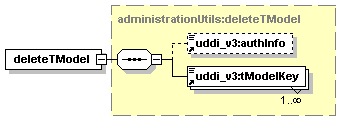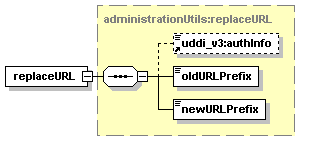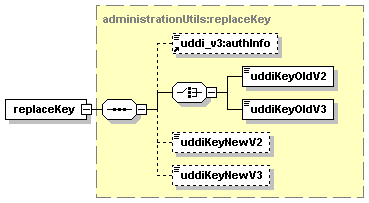Administration Utilities Locate
The Systinet Administration Utilities API provides an interface to perform several low level administration tasks in BEA AquaLogic Service Registry.
Operations Locate
cleanSubscriptionHistory Locate
This utility removes subscription histories from BEA AquaLogic Service Registry. If the olderThan value is not specified, the utility deletes all historical data; otherwise it deletes data older than the specified value.

uddi_v3:authInfo - This optional argument is an element that contains an authentication token.
olderThan - Optional argument specifying the date before which subscription history is deleted.
This API call requires API manager permissions for org.systinet.uddi.admin.AdministrationUtilsApi and for the cleanSubscriptionHistory action.
clean_unusedAccounts Locate
This utility is useful when LDAP is used as a user store. BEA AquaLogic Service Registry treats LDAP as read-only and all data from LDAP is mirrored to the registry's database. After you remove users from LDAP using LDAP tools, data removed from LDAP stays in the database. To remove the orphan data from the database, execute the clean_unusedAccounts operation.

This API call requires API manager permissions for org.systinet.uddi.admin.AdministrationUtilsApi and for the clean_unusedAccounts action.
deleteTModel Locate
The delete_tModel API removes one or more tModels from BEA AquaLogic Service Registry. Note that the delete_tModel call in the UDDI version 3 specification does not physically remove the tModel from the database; it marks the tModel as deprecated. The delete_tModel call from Administration Utilities can be used to delete such deprecated tModels from the database.

uddi_v3:authInfo - This optional argument is an element that contains an authentication token.
uddi_v3:tModelKey - One or more required uddiKey values that represent existing tModels.
This API call requires API manager permission for org.systinet.uddi.admin.AdministrationUtilsApi and the action deleteTModel.
rebuild_cache Locate
Database cache stores v3 UDDI structures in database as objects. Using this cache increases performance of v3 inquiry get_business, get_service, get_binding, get_tModel and find_binding operations. On the other hand the cache synchronization take some time mainly in v1 and v2 publishing API operations. The cache can be enabled or disabled by Registry Console. By default, the cache is enabled. Each time caching is switched on, the cache is rebuilt. After the initial rebuild the cache is incrementally synchronized each time save_xxx or delete_xxx operation is performed on v1, v2, v3 publishing API. Explicit rebuild is enabled by rebuild_cache operation. This operation is suitable when data is changed by an administrator in a SQL console (note that such data changing is not recommended).

uddi_v3:authInfo - This optional argument is an element that contains an authentication token.
This API call requires API manager permissions for org.systinet.uddi.admin.AdministrationUtilsApi and for the rebuild_cache action.
replaceURL Locate
The replaceURL API call is used to replace URL prefixes in the following entities:
tModel - OverviewDoc URL
tModelInstanceInfo - overviewDoc URL and DiscoveryURL
binding template - accessPoint URL

uddi_v3:authInfo - This optional argument is an element that contains an authentication token.
oldURLPrefix - old value of URL prefix
newURLPrefix - new value of URL prefix
This API call requires API manager permission for org.systinet.uddi.admin.AdministrationUtilsApi and the action replaceURL.
replaceKey Locate
The replaceKey API call is used to change the uddiKey of a selected UDDI structure in BEA AquaLogic Service Registry. The key must be specified in either UDDI version 3 format or UDDI version 2 format. The optional elements uddiKeyNewV2 anduddiKeyNewV3 hold new values of uddiKeys for the selected UDDI structure.

uddi_v3:authInfo - This optional argument is an element that contains an authentication token.
uddiKeyOldV2 - Value of the uddiKey of an existing UDDI structure in UDDI version 2 format.
uddiKeyOldV3 - Value of a uddiKey of an existing UDDI structure in UDDI version 3 format.
uddiKeyNewV2 - New value of the uddiKey in UDDI version 2 format.
uddiKeyNewV3 - New value of the uddiKey in UDDI version 3 format.
This API call requires API manager permission for org.systinet.uddi.admin.AdministrationUtilsApi and the action replaceKey.
resetDiscoveryURLs Locate
Sets the discoveryURL value of each businessEntity in BEA AquaLogic Service Registry to its default value.

uddi_v3:authInfo - This optional argument is an element that contains an authentication token.
This API call requires API manager permission for org.systinet.uddi.admin.AdministrationUtilsApi and the action resetDiscoveryURLs.
transform_keyedReferences Locate
This operation is necessary when the type of taxonomy keyValues or the implementation of the taxonomy transformation service have been changed. For more information see, User's Guide, Taxonomy: Principles, Creation and Validation.

uddi_v3:authInfo - This optional argument is an element that contains an authentication token.
uddi_v3:tModelKey
This API call requires API manager permission for org.systinet.uddi.admin.AdministrationUtilsApi and the action transform_keyedReferences.
WSDL Locate
You can find the WSDL specification for this API in administrationUtils.wsdl.
API Endpoint Locate
You can find the Administration Utilities API endpoint at http://<host name>:<port>/uddi/administrationUtils.
Java Locate
The Systinet Java API is generated from Administration Utils WSDL. You are encouraged to browse for more information.